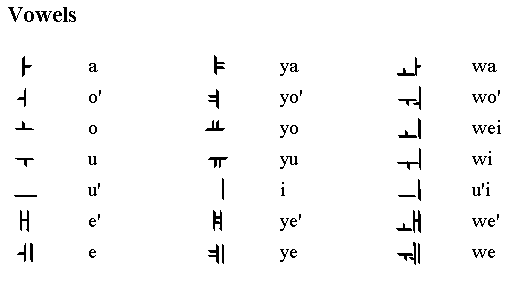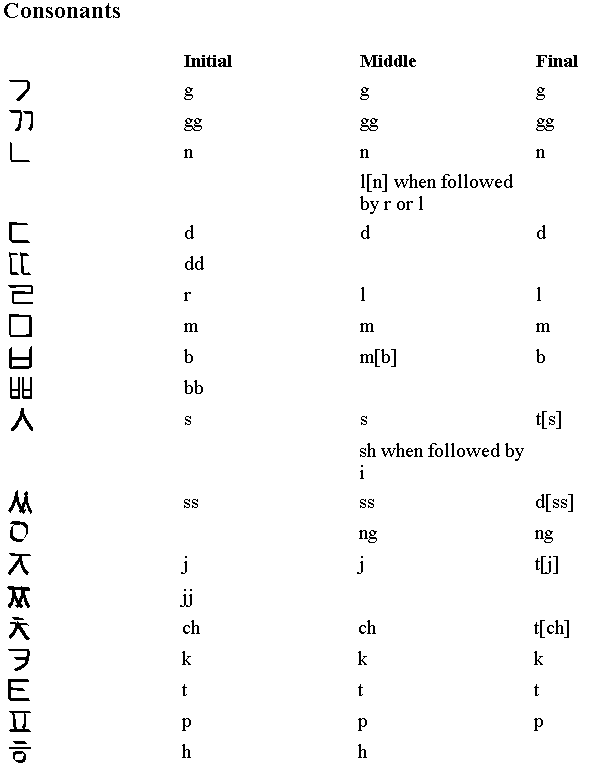
[copied from Sulky Family Web Site]
© 1997 Larry Sulky and Charlie Halpern-Hamu
This romanization system is meant to correspond unambiguously to written Korean using standard keyboard characters, while guiding readers to a broadly accurate pronunciation.
Fine pronunciation distinctions, especially those concerned with aspiration and glottalization, while certainly valid, are not described here. Such information is unlikely to enhance the pronunciation of the casual reader of Korean (in English headlines about Korean locales or personages, for example), while being inadequate for the serious student, who should learn the Korean sounds from audio sources and detailed texts.
This system has some conventions that may be omitted when unambiguous reconstruction of the original written Korean is not necessary. It also has some conventions designed to conform to 7-bit ASCII limitations that can be better represented when appropriate typographic capabilities are available.
Transformations between Korean writing and romanization must be unambiguous in both directions. This priority is met completely.
Only standard North American English keyboard characters need be used. This priority is met completely.
A speaker of a western European language must be able to read romanized Korean aloud, with a minimum of training or rule memorization, with understandable (to a Korean) pronunciation. Any errors due to romanization of sound must be no more severe than those due fundamentally to accent. This priority is met very well; the only unusual conventions are the bracketing of silent and non-phonetic letters.
Romanizations must correspond, to the greatest degree possible, to the Korean letters and syllables as they are written. Special cases must be kept to a minimum. This priority is met well; only the romanizations of the vowel combinations do not correspond letter-for-letter to the original Han-gu'l letters.
Unless otherwise noted, all romanized letters and letter combinations are pronounced as in Latin or, if they do not occur in Latin, as in English. The following points peculiar to this romanization require explanation:
Silent letters in complex consonant combinations are enclosed in braces ({ and }) in ASCII media: yo'-do'l{b}. In media that support it, silent letters are represented instead in reduced-size superscript: yo'-do'lb. In contexts where there is no need for reconstruction of the original Han-gu'l (such as in foreign-language news reports), silent letters can be omitted entirely: yo'-do'l.
In ASCII media, consonants that are written in the original Korean in one way but are pronounced as a different letter are enclosed in brackets ([ and ]), immediately preceded by the romanized letter that best approximates the pronunciation: da-so't[s]. In media that support it, non-phonetic letters are represented instead in reduced-size subscript: da-so'ts. In contexts where there is no need for reconstruction of the original Han-gu'l, the bracketed letters can be omitted entirely: da-so't.
u' is the vowel midway between the e in brother and the u in mute. e' is the vowel midway between the flat a in fat and the long a in fate. o' is the vowel midway between the short u in cut and the short o in cot. The apostrophe is used in ASCII media: Han-gu'l, je'-mi, an-nyo'ng. In media that support it, the apostrophes are replaced by grave accents over these vowels: Han-gùl, è-mi, an-nyòng.
Note that for each of these vowels, pronouncing the vowel as though the apostrophe were not present yields the Korean vowel that is next closest to the correct one. In fact, many Koreans claim to be unable to distinguish between e' and e, and the pronunciation of o' approaches that of o in some phonemic contexts.
All vowel combinations except u'i are preceded by w and pronounced as single sounds.
y is always a consonant. g is always the hard g of guard.
Words are capitalized according to common English rules. They are separated by spaces.
Syllables are separated by hyphens. This is because Korean syllables are clearly represented visually in the written language, and so must be just as clearly (and unambiguously) represented in the romanization. For example, if Han-gu'l were written Hangu'l, its syllables could be read as Hang-u'l, yielding incorrect pronunciation and incorrect Korean spelling. The rules for deciding when such ambiguity can occur are complex and somewhat subjective, so hyphenation is always used regardless. In media that support it, the hyphen is replaced by the small raised dot, which commonly separates syllables in dictionary entries: Han·gùl, da·sòts, yò·dòlb. In contexts where there is no need for reconstruction of the original Han-gu'l (such as in foreign-language news reports) and precision in syllable separation is not necessary, syllable separators can be omitted: Hangùl, dasòt, yòdòl.
The character mapping is shown in the most basic, 7-bit ASCII form.



Vowels, in Unicode order
ᅡ a ᅢ è
ᅣ ya ᅤ yè
ᅥ ò ᅦ e
ᅧ yò ᅨ ye
ᅩ o
ᅪ wa ᅫ wè ᅬ wei
ᅭ yo
ᅮ u
ᅯ wò ᅰ we ᅱ wi
ᅲ yu
ᅳ ù ᅴ ùi ᅵ i
Consonants, in Unicode order
I M F
ᄀ g g g
ᄁ gg gg gg
ᄂ n n n
ᄃ d d d
ᄄ dd
ᄅ r l l
ᄆ m m m
ᄇ b m[b] b
ᄈ bb
ᄉ s s t[s]
ᄊ ss ss d[ss]
ᄋ ng ng
ᄌ j j t[j]
ᄍ jj
ᄎ ch ch t[ch]
ᄏ k k k
ᄐ t t t
ᄑ p p p
ᄒ h h
Consonant combinations
Initial Medial Final
ᄀᄉ ᆪ g{s} g{s}
ᄂᄌ ᆬ nj n{j}
ᄂᄒ ᆭ nh n{h}
ᄅᄀ lg l{g}
ᄅᄆ lm l{m}
ᄅᄇ lb {l}b
ᄅᄉ ls l{s}
ᄅᄐ lt l{t}
ᄅᄑ lp {l}p
ᄅᄒ ᄚ r{h} l{h}
ᄇᄉ bs b{s}